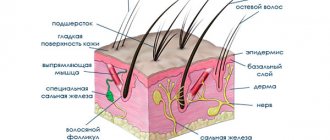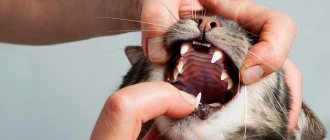The cat is a natural hunter with great agility to pursue its prey. Primarily, their keen sense of smell helps them track down prey. Their sense of smell is not only useful for hunting, but also helps them learn as much as possible about their environment. With such usefulness, anything that can harm their sense of smell can compromise the cat's overall well-being. Swelling or inflammation is one of the most obvious signs of a problem with your cat.
We study what happens when your cat's nose becomes swollen. It is imperative that you recognize this symptom as abnormal and requiring immediate veterinary attention. If this does not happen, the threat to their health may be much more serious than the loss of their ability to smell.
Symptoms Associated with a Swollen Nose in a Cat
As with any cat disease, we need to consider the context in which the cat's nose is swollen. This is especially true when we don't know the source of the problem. By looking at any other possible symptoms, we can better determine the underlying cause of the inflammation and help our veterinarian determine the best treatment option. These symptoms include:
© shutterstock
- Facial deformity (cat with a swollen face)
- Nasal or eye discharge
- Tearing
- Conjunctivitis
- Nasal congestion
- Cough
- Sneezing
- Breath sounds
- Loss of appetite
- Heat
- Apathy
- Bloody issues
Although we may not be able to diagnose the problem ourselves, providing as much information as possible helps to make an accurate diagnosis as soon as possible. This means examining behavioral changes as well as any physical symptoms that may occur.
Cat's nose is swollen due to foreign bodies
A foreign body lodged in a cat's nasal passage is one of the most common causes of nasal swelling. Cats love to explore and smell everything. Just like their reputation, a cat's curiosity can get them into trouble. They may collide face-to-face with or inhale something that will cause them significant damage. A foreign object can vary in size, but anything stuck in your sinuses is no good. Some of the most common objects that get stuck in a cat's nose include:
- Seeds
- Spikes
- Pieces of plastic
- Insects
- Sand/dirt
We may first be alerted to a dog's swollen nose when he sneezes, which is most likely to happen when a foreign body becomes lodged in the nose. The problem may also be accompanied by mucus discharge. We will need to look at the upper respiratory tract to see if there is anything there. However, we must try invasive methods that may cause additional harm.
Cat's nose swollen from insect bites
While this can happen to any cat, those that have an outlet are more likely to be bitten by bugs, parasites, or other bugs. This is because many of these creatures live outdoors. Insects and arachnids that can bite or sting your cat's nose and cause swelling include:
- Wasp
- Bee
- Scorpion
- Mosquito
- Bug
- Spider
The cause of swelling is related to the cat's immune response. Once the tissue detects the presence of a pathogen, the cat's immune response sends antibodies to where it is, and inflammation occurs as they fight it.
Parasites such as ticks and fleas also cause swelling on a cat's nose. They are not as likely here as they prefer other parts of the body. In these cases, in addition to swelling, you will likely see your cat trying to scratch its nose to relieve the itching.
Likewise, exposure to certain plants that are toxic to cats can cause inflammation. If the swelling is a reaction to a toxic substance, it will likely be accompanied by redness, sneezing and scratching, among other symptoms.
What can cause swelling?
There are a huge number of different reasons and even full-fledged diseases that can cause such a problem. Here are the most common and frequently encountered ones:
- Injury. A pet that has free access to the street can easily get into a fight with its relatives. Cat fights are brutal and the claws are sharp: the animals inflict a variety of injuries on each other, and most often the head suffers. Torn eyelids, ears and lips become very swollen. The jaw may be broken and swelling develops at the site of injury. There is a high probability of developing an abscess (abscess) if an infection gets into an open wound.
- Abscess (ulcer, abscess). This is the formation of a cavity in the tissues filled with purulent fluid from decomposed blood cells and tissue fibers. An abscess can develop anywhere, and the most common cause is infection. If your cat's face is swollen in the cheek area, you should also examine the teeth and gums. Diseases of the oral cavity can be accompanied by tissue suppuration - gumboil. Only a veterinarian should open an abscess. Sometimes the cavity quickly grows to a decent size, and then surgery under general anesthesia is required. Treatment of an abscess after surgery is a long and extremely painful process for the animal, since several times a day it is necessary to move the edges of the wound apart, clean the cavity of accumulated secretions and apply a special ointment.
- Insect bite. Most often, pets suffer from hymenoptera bites: wasps, bees, bumblebees. Cats are careful and dexterous animals, but sometimes they get excited and play with dangerous insects. A swelling appears at the site of the bite. The most vulnerable parts of the muzzle are the nose, lips and eyelids. Usually the upper lip swells first, then the area near the eye. If the incident occurred in front of the owner and there is no doubt about the cause of the swelling, you need to take the cat to the veterinary clinic as soon as possible.
- Exoparasites - fleas. Flea saliva and excrement can cause an allergic reaction in your pet. Allergen exposure occurs when a cat catches and bites an insect. As the process progresses, sores appear on the face, which take a very long time to heal.
- Allergy. Another reason why a cat's face is swollen may be an allergic reaction. Anything can be a provoking factor: new food (even high-quality - holistic class), scented toilet litter, shampoo, toilet detergent. It is not recommended to give your pet antihistamines without a veterinarian's prescription. If you suspect an allergy, a visit to the veterinary clinic should not be postponed.
- Snake bites. Even if a cat sees the street only through the window most of the year, at the dacha he is able to demonstrate extraordinary hunting skills. Some cats deftly catch reptiles: lizards and snakes. But during the hunt, the animal may be inferior to the snake in the speed of reaction, and instead of a trophy it receives a bite - most often in the face. Snake venom is toxic and causes an allergic reaction in the form of swelling. If you suspect a snake bite, you should immediately take your pet to the vet.
- Acne (inflammation of the ducts of the sebaceous glands). This disease, which is usually associated with adolescence in humans, also occurs in cats. They also have sebaceous glands that are connected to the hair follicles and provide the coat with a water-repellent effect. There are places on the animal’s body with an increased number of these glands, one of them is the chin. First, inflammation of the sebaceous ducts on the chin is accompanied by the appearance of blackheads (comedones). If the animal is not treated, folliculitis develops - an inflammatory process in which voids with pus form in the follicles. In this case, the muzzle in the chin area may swell noticeably. Although acne is not fatal, it is not recommended to delay a trip to the veterinarian.
- Inflammation of the lymph nodes. Lymphadenitis is inflammation of the lymph nodes, accompanied by severe swelling of the tissue. If your cat's muzzle is swollen in the area of the jaw and upper neck, it may be due to lymphadenitis. Only a veterinarian can make an accurate diagnosis.
- Neoplasm (tumor). The growing tissue of the neoplasm looks like a swelling. Sometimes the tumor puts pressure on the lymphatic vessels, which leads to stagnation of lymph and the formation of edema. If a swelling appears on your pet’s face, you need to urgently contact a veterinary clinic, even if it is small and does not bother the animal at all. The neoplasm may be malignant, and then urgent surgery followed by special therapy will be required.
- Houseplants. Most of them are toxic to cats and can cause poisoning or swelling: after all, they taste all the greens. The list of safe ones is much shorter, the most common are cacti and orchids.
We recommend the article: How to recognize and treat gangrenous stomatitis in a cat
As you can see, the list of possible causes is quite large, so it is not possible to independently determine why the cat’s muzzle is swollen. To make a diagnosis, it is recommended to visit a qualified veterinarian in person.
The cat's nose is swollen from allergies
Inflammation is one of the main symptoms of an allergic reaction in cats. The nose and face of a cat are no exception. Depending on the type of allergy, inflammation may spread to other areas. If the allergen is airborne, the cat's nose and mouth may initially become swollen when inhaled. This is similar to when a cat has a food allergy because the allergens come into contact with its mouth and face first.
As a rule, all types of allergies to cats are manifested by the following symptoms::
- Localized erythema (redness)
- Localized swelling/inflammation
- Itching
- Increased body temperature
- Sneezing
Although a swollen nose may not be serious, large amounts of the allergen can cause a more severe reaction. In these cases, the cat may develop anaphylactic shock. This is a severe and rapidly developing systemic allergic reaction. Symptoms of this reaction include:
- Swelling of the lips, tongue, face, neck and even the whole body
- Difficulty swallowing
- Dyspnea (difficulty breathing)
- Disease
- Vomit
- Abdominal pain
- Heat
- Death (if not treated promptly)
The severity of swelling and other symptoms depends on the time of exposure and the amount of allergens present. This is a veterinary emergency, so if you notice symptoms, take your animal to the veterinarian as soon as possible.
What to do?
Help for your pet is directly related to the cause that caused the swelling of the face. If swelling occurs due to traumatic injuries, the owner should immediately apply a cold compress to the area of injury. With its help it will be possible to relieve swelling and relieve pain. Then the owner needs to take the animal to a veterinary clinic, where an x-ray will be taken to confirm or rule out a possible jaw fracture.
Tumors that occur on the bridge of the nose, in the nose, on the cheeks, chin and other parts of the face begin to be treated after diagnostic measures are carried out. First of all, a biopsy is prescribed to show the nature of the neoplasm: malignant or benign. If a growth of the first type is diagnosed, surgery is mandatory.
An abscess is treated by opening it. If the situation is advanced and the purulent cavity is greatly enlarged, surgical intervention under general anesthesia may be required. After surgery, your pet will face a long and painful recovery period. Every day, the edges of the wound will need to be moved apart to clean the cavity of secretions and put the ointment prescribed by the veterinarian into it. Therapy for allergic reactions involves identifying the allergen and avoiding contact with it. Sometimes the animal may also be prescribed corticosteroids. However, medications from this group have a number of serious side effects, so they are used only in severe situations.
The cat's nose is swollen due to an abscess
When a cat has an abscess on its face, we see significant swelling. The mentioned swelling occurs due to the accumulation of pus. This phenomenon usually causes swelling of the face and nose in cats. An abscess may be a lump under the skin, but when it breaks through the skin, it can create a sore. The main causes of an abscess include:
- Dental problems : When the root of one or more teeth becomes infected, an abscess forms underneath, causing local swelling of the face. A very painful abscess can push upward and make it appear as if the nose itself is swollen.
- Trauma : A scratch or blow to the face is a fairly common cause of a swollen nose in your cat. This could happen if they hit something sharp, got scratched too much, or got into a fight with another animal. Bacteria entering the wound site can cause inflammation.
Treating abscesses in cats requires cleaning and disinfecting the wound. In more severe cases, treating the problem may require draining the abscess and using antibiotics.
© shutterstock
Cancer (neoplastic)
Various types of cancerous tumors occur in the nasal cavity. The most common type in cats is adenocarcinoma, but other types, including soft tissue sarcoma and lymphoma, also occur. Cancerous tumors can cause problems in one or both nostrils. Possible deformation of the muzzle. Usually, with neoplasms in an animal, changes can be seen on MRI or CT. Ultimately, to determine the type of tumor, it is necessary to do a biopsy, taking a piece of tissue for histological examination (evaluating a section of tissue under a microscope), or a puncture for cytological examination (evaluating cells in a smear). Treatment for cancer depends on its type. Endoscopic removal of the tumor, rhinotomy, radiation and chemotherapy are likely.
Feline cryptococcosis and swollen nose
Cryptococcosis in cats is caused by the fungi Cryptococcus neoformans or Cryptococcus gatti. These fungi are present in soil, bird droppings and some plants. They can be transmitted by inhalation. The result can be a pulmonary granuloma, a structure formed by inflammation due to various diseases. Immune cells known as macrophages attempt to cloak and wall off the agent or pathogen (in this case, a fungus) to prevent harm.
Cryptococcosis also affects dogs, ferrets, horses and humans. The condition is most often asymptomatic, meaning it does not show any observable symptoms. When clinical symptoms occur, they usually involve nasal problems, problems affecting the nervous system, skin problems, or other systemic reactions. Nasal symptoms are characterized by inflammation of the nasofacial area, which is accompanied by ulcers and nodules in this area.
Another very common symptom is a swollen cat's face, known as a " clown nose ." This is associated with characteristic swelling of the nose and inflammation of the sinuses. Other symptoms include sneezing, nasal discharge and swollen lymph nodes. Cats often have a runny nose and bloody discharge, especially when sneezing.
To accurately identify cryptococcosis in a cat, a biopsy and/or culture for the fungus is usually performed. The fungus can remain dormant for months or even years before symptoms appear, making it very difficult to determine its origin.
Causes
There are many reasons why a cat has a runny nose. Before you figure out what causes the release of mucous or purulent exudate from the nasal passages, you need to know what mucus is and what it is needed for. The role of mucus in the nasal passages is as follows:
- retention of foreign particles penetrating into the nasal cavities (various household dust, pathogenic bacterial microorganisms, fungi and viruses);
- creating the necessary humidity in the nasal sinuses to clean and regulate the heat of the air entering the lungs;
- disinfecting effect of viral and bacterial microorganisms penetrating from the environment (antiseptic is created due to the protein - mucin).
Physiological secretions of mucous exudate from the nasal passages contain protein components, water and various salts. Irritation of the mucous membrane due to a number of pathological factors provokes increased activity of cellular structures, which leads to a large amount of secretion that is not excreted properly. Rhinitis occurs, and the cat is leaking clear fluid.
Part of the secretion produced by the mucous glands exits through the nasal passages, and part passes down the nasopharynx.
Factors that indirectly influence the general appearance of nasal discharge are varied. The main ones are:
- type of inflammatory process;
- the presence of pathogenic microflora in secret;
- viscosity of mucous discharge.
Normal nasal discharge, thin and clear. Normally, they come out of the nasal passages on their own in small quantities, moisturizing it. This happens with the help of ciliated epithelium located on the mucous part. With pathological changes in the body, provoked by viruses, bacteria or allergens, the mucus becomes thick and its outflow is disrupted, clogging the nasal passages and causing swelling.
The type of inflammation in rhinitis can be catarrhal (it is characterized by the appearance of a large amount of clear liquid, without color and liquid consistency) and purulent (the cat has pus flowing from the nose). Purulent inflammatory processes are characterized by the appearance of thick, yellowish or greenish discharge. The color saturation and consistency of snot directly depends on the number of pathogenic microorganisms filling the nasal passages.
The main reasons for the development of a runny nose and nasal discharge in a cat are infectious diseases. Various viruses, fungi, protozoa and pathogenic bacteria cause not only rhinitis, but also other changes in the body. In the vast majority of cases, cats are diagnosed with calcivirus infection, rhinotracheitis, mycoplasmosis and chlamydia. Cryptococcal infections and asperegylosis are less common.
The lack of adequate treatment for the acute phase of rhinitis can provoke the further development of a chronic form of a bacterial nature. Treatment of chronic bacterial rhinitis is quite problematic and requires a special approach.
Other causes of nasal discharge in cats include:
- Nasopharyngeal polyps. Specific growths in the nasal passages that provoke disturbances in the act of swallowing, normal nasal breathing becomes difficult, and chronic sneezing occurs. It is diagnosed more often in cats at a young age. The cause of the development of polyps is considered to be inflammatory processes of bacterial origin in the middle ear.
Tumor processes in the oral cavity and nose. Old cats that are diagnosed with lymphosarcoma, fibrosarcoma or adenocarcinoma are susceptible to developing tumors in the nose and mouth. A sign of a malignant neoplasm is that the cat has bleeding from the nose, severe swelling in the muzzle, and visual deformation of the nasal septum.
Stuck foreign body. An object entering the animal's nose blocks the passages and causes a blockage. As a result of mechanical impact, swelling of the nasal cavity occurs and copious discharge appears. Thus, with the help of secreted secretions, the body tries to get rid of the foreign object.
Congenital anomalies. In some cases, if there is a violation in embryonic development, the cause of discharge from the cat’s nose is a cleft palate, cleft lip, or deformation of the nasal septum.
Mechanical injuries to the skull and jaw. As a result of displacements of bone structures, the development of chronic rhinitis is possible.
It is impossible to identify the true cause of the development of rhinitis on your own. You need to contact a veterinarian. Only in a veterinary hospital is it possible to establish an accurate diagnosis.
The specialist conducts a general examination, establishing the nature of the discharge - hemorrhagic, serous, purulent. Next, laboratory and instrumental studies are prescribed. Suspicion of a viral etiology of rhinitis is confirmed or refuted by laboratory tests. Nasal and conjunctival swabs are collected.
Diagnosis of the presence of bacterial or fungal pathogenic microflora in the nasal passages is made possible by bacterial cultures on nutrient media. In addition, bacterial culture allows not only to determine the type of pathogen, but also to select the most sensitive antibiotic for treatment.
Self-prescribing antimicrobial agents without preliminary diagnosis is prohibited. This can cause serious complications. In addition to the complete lack of therapeutic effect, the pathology may become chronic with regular relapses.
Suspecting nasopharyngeal polyps or tumors in the nasal passages, the veterinarian prescribes additional diagnostic methods - x-ray examination or rhinoscopy. Rhinoscopy involves taking tissue from the nasal passages for histological examination. This allows you to determine the neglect of the process and its nature (malignant or benign). This allows you to prescribe the most appropriate therapy. Experts strongly recommend closely monitoring your pet if it develops discharge from the nasal passages. In some cases, there is no need to worry, but there are diseases whose symptom is rhinitis that require immediate treatment.
Viral infections nasal swelling in cats
Feline AIDS virus (FiV), feline leukemia virus (FeLV), herpes virus, or calicivirus can also cause nasal inflammation. They may also be accompanied by sneezing and even sores and crusts on the cat's nose. Each disease will also have other specific symptoms associated with it. A viral sinus infection such as rhinitis can also lead to nasal swelling.
Treatment for the virus usually involves treating the symptoms of the condition. Antiviral medications may be available, but this will depend on the specific disease and clinical presentation of the individual cat. Likewise, it is very important to ensure that your cat's vaccination schedule is up to date to prevent contracting the virus in the first place.











